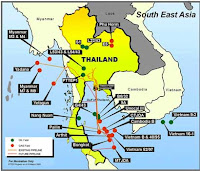 |
| Timor Leste Oil and Gas Fields |
TIMOR LESTE has become an independent country. Large deposits of oil and natural gas under the Timor Sea, in Timor-Leste’s territory as well as that of neighboring Australia and Indonesia, have been explored for more than forty years. During 2006, new exploration contracts were signed for areas in the Joint Petroleum Development Area (JPDA) and in Timor-Leste’s exclusive maritime territory.



